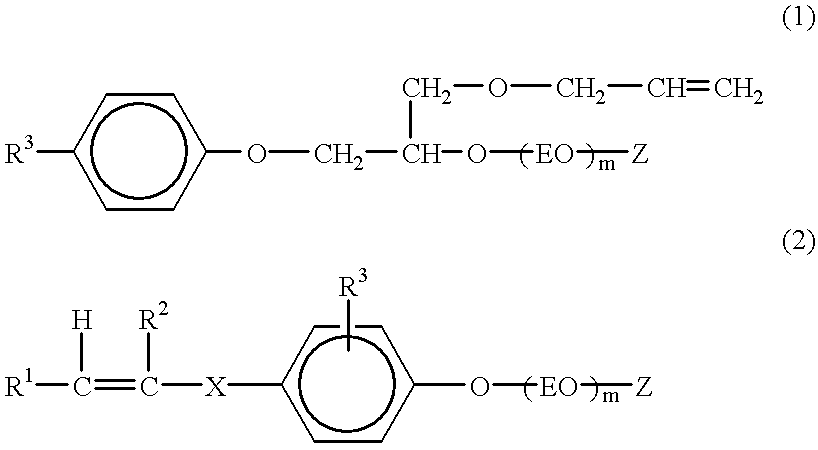Polymer obtained by emulsion polymerization method
a polymerization method and emulsion technology, applied in the field of polymer, can solve the problems of unfavorable air pollution and toxicity, undetectable specific odor of the polymer dispersion obtained in the presence of mercaptans, and relatively large content of chain transfer agents remaining in the polymer dispersion, and achieve excellent affinity not only with pigments
- Summary
- Abstract
- Description
- Claims
- Application Information
AI Technical Summary
Benefits of technology
Problems solved by technology
Method used
Image
Examples
example 1
First, a vessel equipped with a dropping pump was charged with 31 parts by weight of deionized water and 5 parts by weight of an anionic reactive emulsifier .left brkt-top.Aquaron HS-10.right brkt-bot. [sodium polyoxyethylene (n=about 10) nonylpropenylphenyl ethersulfate; effective ingredient about 100% by weight; manufactured by Asahi Denka Ind. Co., Ltd.] and stirred to dissolve them. Then, a monomer mixed solution comprising 42.7 parts by weight of methyl methacrylate (MMA), 52.3 parts by weight of 2-ethylhexyl acrylate (EHA) and 5 parts by weight of acrylic acid (AA) was dropwise added under stirring to obtain a monomer emulsion.
Next, a pressure proof reactor equipped with a stirrer, a pressure gauge, a thermometer and a dropping pump was charged with 120 parts by weight of deionized water and substituted with nitrogen. Then, it was heated to 150.degree. C. after sealing, and 10% by weight of the monomer emulsion described above was added to the pressure proof reactor. Further, ...
example 2
A vessel equipped with a dropping pump was charged with 31 parts by weight of deionized water, 2.5 parts by weight of .left brkt-top.Neogen R.right brkt-bot. and 0.8 part by weight of .left brkt-top.STK-199.right brkt-bot. [polyoxyethylene (n=about 30) nonylphenyl ether; effective ingredient about 70% by weight; manufactured by Kao Corp.] and stirred to dissolve them. Then, a monomer mixed solution comprising 95 parts by weight of styrene and 5 parts by weight of 2-hydroxyethyl acrylate was dropwise added while stirring to obtain a monomer emulsion.
The same reactor as used in Example 1 was charged with 120 parts by weight of deionized water and 0.3 part by weight of an anionic emulsifier .left brkt-top.Neogen R.right brkt-bot. [sodium alkylbenzenesulfonate; effective ingredient about 60% by weight; manufactured by Daiichi Kogyo Ind. Co., Ltd.] and substituted with nitrogen. Then, it was heated to 185.degree. C. after sealing.
Added to the pressure proof reactor was 5 parts by weight ...
example 3
The same operation as in Example 2 was carried out, except that 52 parts by weight of styrene, 15 parts by weight of methyl methacrylate, 30 parts by weight of butyl acrylate and 3 parts by weight of acrylic acid were used as monomers and the 5 weight % hydrogen peroxide aqueous solution was changed in an amount from 75 parts by weight to 95 parts by weight and that the reaction temperature was changed from 185.degree. C. to 145.degree. C. The polymer thus obtained was analyzed, and as a result thereof, it had a weight average molecular weight (Mw) of 12,500, a number average molecular weight (Mn) of 5,200, a molecular weight peak (Mp) of 11,000 and Mw / Mn of 2.4.
PUM
| Property | Measurement | Unit |
|---|---|---|
| Temperature | aaaaa | aaaaa |
| Angle | aaaaa | aaaaa |
| Angle | aaaaa | aaaaa |
Abstract
Description
Claims
Application Information
 Login to View More
Login to View More - R&D
- Intellectual Property
- Life Sciences
- Materials
- Tech Scout
- Unparalleled Data Quality
- Higher Quality Content
- 60% Fewer Hallucinations
Browse by: Latest US Patents, China's latest patents, Technical Efficacy Thesaurus, Application Domain, Technology Topic, Popular Technical Reports.
© 2025 PatSnap. All rights reserved.Legal|Privacy policy|Modern Slavery Act Transparency Statement|Sitemap|About US| Contact US: help@patsnap.com

